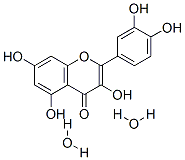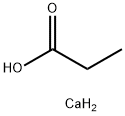Mildronate dihydrate
Synonym(s):MET 88;Quaterin
- CAS NO.:86426-17-7
- Empirical Formula: C6H14N2O2.2H2O
- Molecular Weight: 182.218
- MDL number: MFCD00876389
- EINECS: 695-494-3
- SAFETY DATA SHEET (SDS)
- Update Date: 2024-10-16 17:52:58

What is Mildronate dihydrate?
Description
Meldonium is a zwitterionic compound that was developed in Latvia in 1970 as an anti-ischemia drug. AS Grindeks, a Latvian pharmaceutical company, markets small quantities of it in Eastern Europe.
But meldonium is better known as a doping drug that athletes use to enhance performance. At the beginning of this year, the World Anti-Doping Agency added meldonium to its list of banned substances. Soon thereafter, tennis star Maria Sharapova became the first prominent athlete to have been affected by this ban.
After failing a drug test at the Australian Open, Sharapova announced that she had taken the drug for many years and was not aware of the ban. The International Tennis Federation suspended her for 2 years, but Sharapova appealed the ban. The Court of Arbitration for Sport will likely consider the appeal later this month.
Description
Mildronate is an inhibitor of biosynthesis of L-carnitine by gamma-butyrobetaine (GBB) hydroxylase and as a competitive inhibitor of renal carnitine reabsorption.Mildronate (40 μM) inhibits the reaction of γ-butyrobetaine hydroxylase with γ-butyrobetaine with Km and Vmax of 36.8 μM and 0.08 nmol/min/mg protein, respectively.
The Uses of Mildronate dihydrate
Meldonium dihydrate has been used as an anti-ischemic agent to evaluate its protective effects on Ischemia-reperfusion (I/R) in chick embryos.
Biochem/physiol Actions
Meldonium is an Inhibitor of γ-butyrobetaine hydroxylase (BBOX) a key enzyme in the synthesis of carnitine.
Properties of Mildronate dihydrate
| Melting point: | 85 - 87°C |
| storage temp. | 2-8°C |
| solubility | H2O: >40mg/mL |
| form | powder |
| color | white to off-white |
| Stability: | Hygroscopic |
Safety information for Mildronate dihydrate
| Signal word | Warning |
| Pictogram(s) |
 Exclamation Mark Irritant GHS07 |
| GHS Hazard Statements |
H315:Skin corrosion/irritation H319:Serious eye damage/eye irritation H335:Specific target organ toxicity, single exposure;Respiratory tract irritation |
| Precautionary Statement Codes |
P261:Avoid breathing dust/fume/gas/mist/vapours/spray. P264:Wash hands thoroughly after handling. P264:Wash skin thouroughly after handling. P271:Use only outdoors or in a well-ventilated area. P280:Wear protective gloves/protective clothing/eye protection/face protection. P302+P352:IF ON SKIN: wash with plenty of soap and water. P305+P351+P338:IF IN EYES: Rinse cautiously with water for several minutes. Remove contact lenses, if present and easy to do. Continuerinsing. |
Computed Descriptors for Mildronate dihydrate
| InChIKey | JFWLFLLRLZSBRA-UHFFFAOYSA-N |
New Products
Tert-butyl bis(2-chloroethyl)carbamate 4-Methylphenylacetic acid N-Boc-D-alaninol N-BOC-D/L-ALANINOL N-octanoyl benzotriazole 3-Morpholino-1-(4-nitrophenyl)-5,6-dihydropyridin- 2(1H)-one Furan-2,5-Dicarboxylic Acid DIETHYL AMINOMALONATE HYDROCHLORIDE 1,1’-CARBONYLDIIMIDAZOLE R-2-BENZYLOXY PROPIONIC ACID 1,1’-CARBONYLDI (1,2-4 TRIAZOLE) N-METHYL INDAZOLE-3-CARBOXYLIC ACID (2-Hydroxyphenyl)acetonitrile 4-Bromopyrazole 5-BROMO-2CYANO PYRIDINE 5,6-Dimethoxyindanone 5-broMo-2-chloro-N-cyclopentylpyriMidin-4-aMine 2-(Cyanocyclohexyl)acetic acid 4-methoxy-3,5-dinitropyridine 1-(4-(aminomethyl)benzyl)urea hydrochloride 2-aminopropyl benzoate hydrochloride diethyl 2-(2-((tertbutoxycarbonyl)amino) ethyl)malonate tert-butyl 4- (ureidomethyl)benzylcarbamate Ethyl-2-chloro((4-methoxyphenyl)hydrazono)acetateRelated products of tetrahydrofuran








You may like
-
 Mildronate dihydrate >98% (HPLC) CAS 86426-17-7View Details
Mildronate dihydrate >98% (HPLC) CAS 86426-17-7View Details
86426-17-7 -
 Mildronate dihydrate 95% CAS 86426-17-7View Details
Mildronate dihydrate 95% CAS 86426-17-7View Details
86426-17-7 -
 Meldonium dihydrate CAS 86426-17-7View Details
Meldonium dihydrate CAS 86426-17-7View Details
86426-17-7 -
 1975-50-4 98%View Details
1975-50-4 98%View Details
1975-50-4 -
 2-HYDROXY BENZYL ALCOHOL 98%View Details
2-HYDROXY BENZYL ALCOHOL 98%View Details
90-01-7 -
 14714-50-2 (2-Hydroxyphenyl)acetonitrile 98+View Details
14714-50-2 (2-Hydroxyphenyl)acetonitrile 98+View Details
14714-50-2 -
 118753-70-1 98+View Details
118753-70-1 98+View Details
118753-70-1 -
 733039-20-8 5-broMo-2-chloro-N-cyclopentylpyriMidin-4-aMine 98+View Details
733039-20-8 5-broMo-2-chloro-N-cyclopentylpyriMidin-4-aMine 98+View Details
733039-20-8